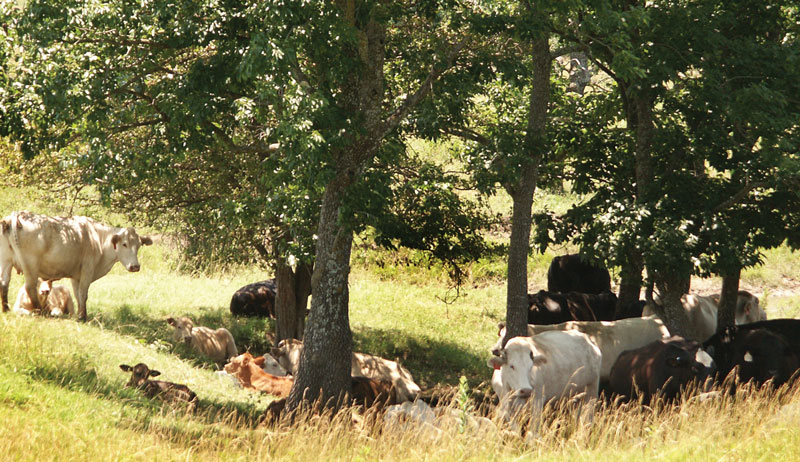
Most cattle do better in cold weather than hot weather. Their thick hide and hair helps keep them warm but makes it more difficult to dissipate body heat on a hot day. They don’t do well in extremely hot weather—especially if it’s humid—and can be at risk for heat stroke.
Cattle have fewer sweat glands than horses or humans. Sweating is not a great way for cows to cool themselves. Instead, they breathe faster—for more air exchange in the lungs; bringing in cooler air—or pant with their mouths open if they are very hot.
Consider the following tips to help your cattle survive the upcoming heat and humidly of summer.
Shade
If there’s no natural shade in their pasture or pen, create a shade roof so they can get out of the direct sun.
Put the roof on tall posts. A metal roof should be insulated to prevent radiant heating, which would make it hotter underneath.
A shade roof should be at least 10 feet high—preferably higher—to allow air movement underneath it. You want all the airflow possible. A breeze can help cool the cattle.

Water
Cattle also need plenty of fresh, clean water that is cooler than 80 degrees Fahrenheit. Don’t place the water tank in the sun where the water will get hot, or cattle won’t drink much. If they get dehydrated they are more at risk for heat stroke.
Situate the water tank in a shady area or build a shade roof over it. If water is cool, cattle drink more.
Cattle need at least 2 gallons per 100 pounds of body weight each day or even more if the day is very hot. Provide more than one water source if there are very many cattle in a pen or pasture. Otherwise the dominant animals might stand next to it and keep the others away.
Check out these 5 miniature cattle breeds that are perfect for small farms.
Provide Salt
Make sure cattle always have access to a trace mineral mix that contains a lot of salt.
They do sweat some during hot weather and lose salt and minerals (electrolytes) via sweat. These must be replenished or they will be more at risk for dehydration.
Fly Control
Use some kind of fly control to reduce biting flies. Cattle expend energy fighting flies, which creates body heat.
They might bunch up when fighting flies, too. In a tight group, there’s not much airflow over and around their bodies, and they suffer more heat stress.
No Exertion
Don’t move or work cattle during the heat of the day. Exertion makes them hotter. If you need to tag, vaccinate, wean, sort or haul cattle, do it early in the morning when temperatures are coolest.
Learn more about how to get started with a herd of stocker cattle.
Spray Them With Water
If cattle are at risk for heat stroke during a period of hot weather, spraying them with water can help cool them.
Hot cattle appreciate a sprinkler system in their pasture. You’ll see them standing under the sprinkler or in the fine mist of water drifting from it.
If your climate cools off at night, cattle can dissipate accumulated body heat during cooler night temperatures. But if it stays hot and humid they can’t get any relief at night. Their body temperature will keep increasing and eventually put them at risk for heat stroke if you have very many hot days and nights in a row.
Find a way to cool them. Spraying them with cool water might be your best option in that situation.
This article originally appeared in the July/August 2019 issue of Hobby Farms magazine.




